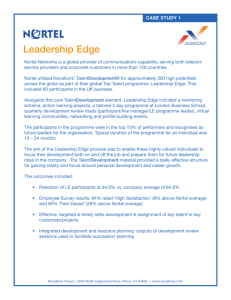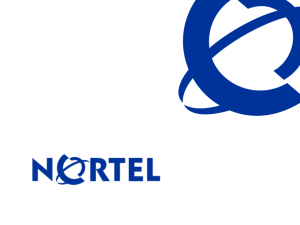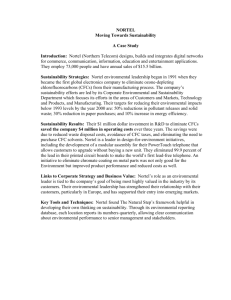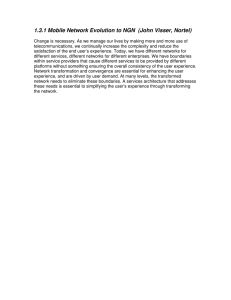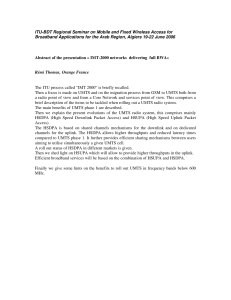Introduction of 3G technologies in 2G bands Agenda
advertisement
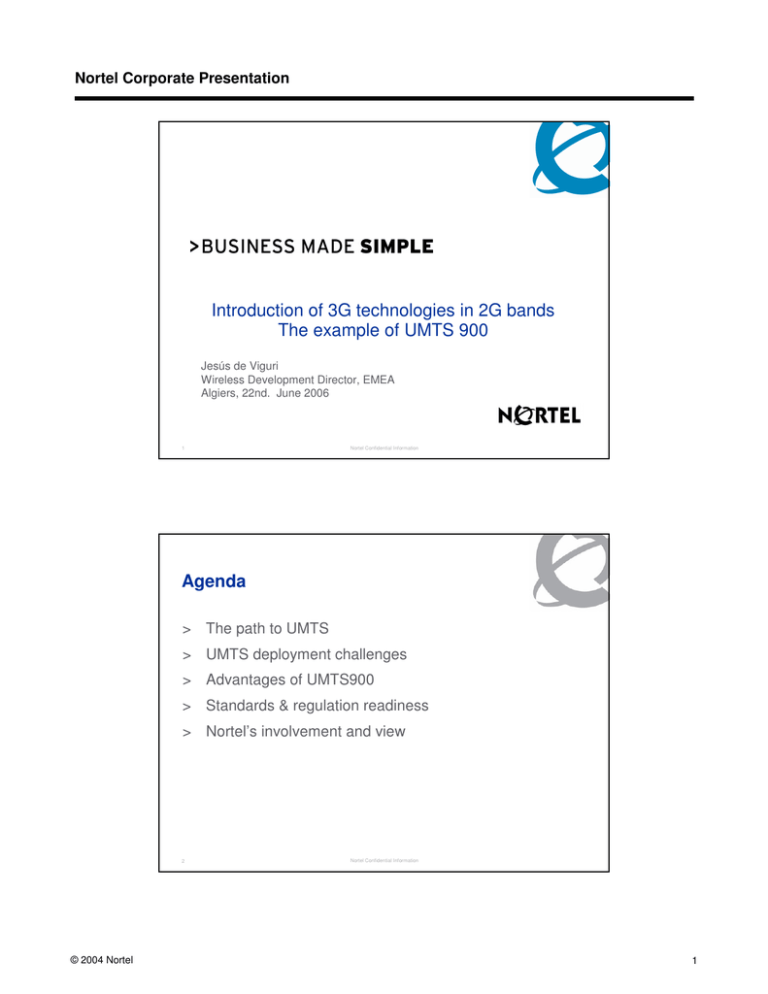
Nortel Corporate Presentation Introduction of 3G technologies in 2G bands The example of UMTS 900 Jesús de Viguri Wireless Development Director, EMEA Algiers, 22nd. June 2006 1 Nortel Confidential Information Agenda > The path to UMTS > UMTS deployment challenges > Advantages of UMTS900 > Standards & regulation readiness > Nortel’s involvement and view 2 © 2004 Nortel Nortel Confidential Information 1 Nortel Corporate Presentation The path to UMTS > Wireless technology history is short but remarkable. • 1G basic mobile voice based on analog systems and national service (e.g. AMPS) • 2G digital and international systems based on CDMA or TDMA (e.g GSM) in the 1990’s. • By 1995 mobile systems had grown rapidly, and user were demanding wireless data services giving rise to third generation (3G) systems such as UMTS. > UMTS allows the introduction of new services, • video telephony that allows video communication using the mobile • high-speed data services, e.g. already deployed HSDPA at 3.6 Mbps > At WARC-92 (World Association Radio Conference, 170 Mhz of spectrum were reserved for IMT 2000 terrestrial components in the range of 1885 to 2220 Mhz Nortel Confidential Information 3 UMTS deployment challenges > UMTS deployment is slower than desired • UMTS is an overlay network • Most of Operator’s revenue is still on GSM business • UMTS coverage is significantly inferior than GSM network coverage > What are the main factors for this? • Deployment cost • The spectrum allocated for UMTS implies greater number of BTS’s needed for covering the same area and to avoid propagation issues (indoor solutions) • Site acquisition problem > As user moves from GSM to UMTS, spectrum in the band of 900Mhz will become available 4 © 2004 Nortel Nortel Confidential Information 2 Nortel Corporate Presentation Advantages of UMTS900 > The difference of radiowave propagation pathloss between 900 MHz and 2 GHz in the same environment can be more than 11 dB > For offering the same service (data rate), the cell range of UMTS900 in rural area is about two times of that of UMTS2000 CS64 PS384 2 GHZ 900 MHz Nortel Confidential Information 5 Advantages of UMTS900 •Up to 60% site count reduction •Up to 25% in-building penetration gain •GSM 900 site reuse Case study: rural area of 64 000 km² Service 2 Ghz 900 Mhz Site Number Reduction (%) 6 © 2004 Nortel CS64 224 90 60 PS384 468 181 61 Nortel Confidential Information 3 Nortel Corporate Presentation Advantages of UMTS900 > Reuse of existing GSM sites will reduce tremendously the cost of UMTS900 deployment • Reuse of the existing sites • Reuse of the existing antenna systems and feeders • Adding new BS cabinet or replacing the existing GSM BTS by a multi-mode GSM+UMTS Base Station 7 Nortel Confidential Information Deployment strategies > UMTS900 with HSDPA/HSUPA to be deployed in rural area by reusing the existing GSM sites to offering voice and high speed mobile internet service > UMTS900 with HSDPA/HSUPA to be deployed in suburban and small cities by reusing the existing GSM sites to offering voice and high speed mobile internet service with good indoor coverage quality > UMTS900 with HSDPA/HSUPA to be deployed in big cities for offering voice and high speed mobile internet service with good deep indoor coverage 8 © 2004 Nortel Nortel Confidential Information 4 Nortel Corporate Presentation Standards & regulation readiness > Proposal of Orange at Ran Plenary #26 in December 04 • 11 companies confirmed as supporting: • Orange, Nortel, Alcatel, SFR, Lucent, Telefonica, BouyguesTelecom, O2, Qualcomm Europe, Nokia, Sagem > UMTS900 work item was approved by 3GPP RAN plenary in December 2004. > Work item completed end November 2005 and specs available > UMTS900 (band VIII) included in the release 3 European harmonised standards EN301908xx series by ETSI/TFES • Final draft version of European harmonised standards Release 3 finalized in 2006-02. • They should be published before end of 2006 after approval and public consultation process. > ECC-PT1 sharing studies on going for UMTS operating in 900 MHz and 1800 MHz bands > A new ECC decision on UMTS900 and UMTS1800 band plan and channel arrangement is planned to be finished by September 2006 Nortel Confidential Information 9 Nortel’s strong involvement in UMTS 900 > Nortel has been driving UMTS 900Mhz standardization • 3GPP: studies from Dec04 to Dec 05 • Nortel is the 3GPP Technical prime • European Regulatory: CEPT/ECC’s decision expected in Sep 06 • National spectrum re-distribution expected in 2007 > Nortel – Qualcomm co-development • UMTS & HSDPA 900 Mhz (cat6 @ 3.6Mbps) demonstration during 3GSMWC 2006 > Advanced Engineering studies for leading Wireless Operators > Time to Market UMTS 900Mhz solution > Leading GSM Spectral Efficiency feature • Enabling freeing up Spectrum for UMTS 900 deployment >Live UMTS/HSDPA 3.6 Mbit/s at 900 MHz >Nortel Driver of UMTS 900 MHz Specifications at 3GPP completed in December 2005 10 © 2004 Nortel Nortel Confidential Information 5 Nortel Corporate Presentation Nortel Product Strategy > Nortel UMTS 900 products will inherit all existing UMTS functionality including HSDPA and HSUPA > Node B : • Digital rack common with 2100 Mhz • New RF modules • Dual band support without forklift > RNC can support 900 and 2100 BTS simultaneously > Mobility & RRM are applied in the same way than in UMTS Nortel Confidential Information 11 Nortel View > Optimum solution for Rural Rollout due to improved coverage. Will Significantly reduce number of Rural coverage sites > Capex savings up to 40% on Access investment thanks to reduction of Node B units > A good solution when 2G and 3G networks will merge • Good indoor coverage in Urban areas > Nortel Aggressive Lead time for 900Mhz: • Leverage US GSM/UMTS 1900 and 850 development • 900MHz prototype RF components exist today for UMTS Node B • Terminal Manufacturers available 2007 12 © 2004 Nortel Nortel Confidential Information 6 Nortel Corporate Presentation 13 © 2004 Nortel Nortel Confidential Information 7
